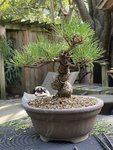Eric Group
Masterpiece
What soil change did you make?In my opinion, it was weak because of poor soil and bad repotting technique (on my part). It's in the same pot and same part of the part of the bench as before.
Scott
I have two older JBP- one in the ground, one in a pot and the one in the pot is a lighter green suddenly than the one in the ground... not dramatically so but it is noticeable to me. The one in a pot was only growing out for a couple years so when I took it out of the ground the roots were not terribly over grown and it went straight into a large training pot with Boone's mix. More than a 50% soil replacement but less than 100%... Just thinking about ways to maximize it's health next growing season. I may have been a little light on fertilizer this year but that is the only thing I can think of. It doesn't have any needle cast that I can see...
I also have a 2 yr old JRP I was growing out in the ground that just went from perfectly dark green to pretty much DEAD looking (all needles faded to light green, then yellow now turning brown!) in like one week
(While I was in Omaha for training... bet it got no water during that time but in the ground I would think it would have still been ok)! We had some freezing nights but not even below 30!! I have no idea what happened there... everything around it seems fine.





